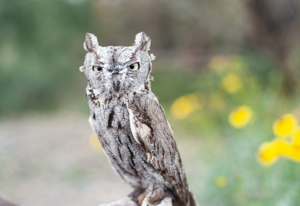Western Screech Owl – Mars
Name: Mars – Male 
Species: Western Screech Owl
Liberty Arrival: 2022 / Nestling
Injury/Condition: Severe head trauma
Mars arrived as a nestling who appeared to have fallen from his nest. He could not sit upright due to weakness on his right side, and had a head tilt to the left eye. While the eye and weakness resolved, Mars continued to show signs of neurological deficiency. For this reason, Mars would be unable to survive on his own in the wild, making him non-releasable.
Western Screech Owl Facts
Description: Western Screech Owls are small, stocky owls with a squarish head. Their plumage varies from gray to brown, though they generally have dark streaks on their belly, with a dark border around the face and yellow eyes.
Habitat: Western Screech Owls live in forests, but are generally tolerant of people. They can often be found in suburbs or parks where cavities are available for nesting. In the Arizona desert, they’re often found in Saguaro cacti where they will use abandoned woodpecker nests.
Range: Western Screech Owls are found on the west coast, up through coastal Canada and into Mexico. They are non-migratory in their area.
Life span: Western Screech Owls can live up to 8-10 years in the wild and 13 in captivity.
Prey: Western Screech Owls eat mostly small mammals such as pocket mice, deermice, and shrews. They can also eat insects, birds, crayfish, snails, and scorpions. They have been noted to catch bats and amphibians.
Nests: Western Screech Owls are second cavity nesters and takeover those excavated by woodpeckers or that are naturally occurring. The male will find a suitable cavity, then call the female to it, where he may entice her with prey.
Babies: Western Screech Cowls lay 2 – 7 eggs in a clutch. Babies hatch after about 26 – 34 days. Youngsters fledge (learn to fly) about 35 days later but will remain for several weeks before leaving the nest site.


